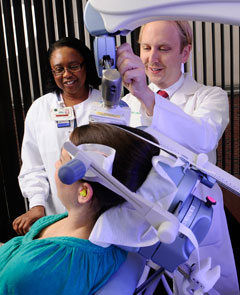New UAB Treatment Dispels Depression with Magnetism
By Bob Shepard
 |
UAB is the first medical provider in Alabama to offer repetitive Transcranial Magnetic Stimulation treatments to patients suffering from depression. To learn more about this new form of therapy, click here. |
Julia Rogers has battled depression for two decades. It has caused serious issues in her life, both personally and professionally. She tried medications—lots of them—with no real effect. Most days, she had to struggle just to function at all.
Depression is a difficult illness to treat because no single therapy works every time in every patient. Psychiatrists now have very good medications to offer, but many patients still find little relief. Psychotherapy and electroconvulsive therapy (ECT) are also successful for some patients, but they do little for others.
That’s why UAB psychiatrist Bates Redwine, M.D., is so excited about the university’s new repetitive Transcranial Magnetic Stimulation, or rTMS, device. This non-invasive treatment delivers a series of highly focused, MRI-strength magnetic pulses to a particular area of the brain linked to depression—the left dorsolateral prefrontal cortex. The Food and Drug Administration approved rTMS therapy within the past two years, and UAB’s device is the only one in Alabama.
“The left dorsolateral prefrontal cortex is known to have decreased activity in depressed patients,” says Redwine. “rTMS seems to ‘wake up’ the neurons, stimulating them to fire and become more active.”
Exciting New Option
Redwine says the idea that depression may be centered in the left dorsolateral prefrontal cortex comes from examination of stroke patients. People who have strokes in this area have dramatically higher rates of depression than people with strokes in other parts of the brain. Functional MRI and PET studies show that the metabolism in this region is decreased in people who are depressed.
Activating the region with rTMS seems to bring relief, and even total recovery, for some patients. Redwine says clinical trials of the rTMS system, which is produced by NeuroStar, showed that more than half of patients treated had significant improvement in symptoms of depression, and a third had complete remission of all symptoms.
“It’s always good to have something else that we can use to treat depression,” Redwine says. “For those who don’t tolerate other treatments, or who just don’t respond to them, it’s good to have another therapy in our toolkit that might prove to be more effective.”
The rTMS therapy has been a revelation for Julia Rogers. “I was diagnosed with major depression more than 20 years ago,” Rogers says. “I wasn’t able to do anything. I mostly just took to my bed or stayed in my home.” But after five weeks on rTMS therapy, things have changed. “It has been wonderful. This is the first time in 20 years that I’ve felt this way,” Rogers says. “I’m able to go out now and do things that other people take for granted. That’s a big thing for me. I’m able to go to church. I have a new grandson who is 12 months old, and I’m finally able to babysit him, play with him, and interact with him. This is the first time I’ve been able to do that.”
Mood Ring
The rTMS unit aims a focused beam of magnetic energy—about the size of a roll of quarters—directly through the scalp to the target area. Therapy lasts 40 minutes per day, five days a week, for at least four to six weeks.
“Studies have shown that patients tend to start responding at about four weeks,” says Redwine. “Over time, with repeated stimulation, we see a sustained effect of increased metabolism in that part of the brain. The more treatments you have, the more sustained the effect.”
Side effects are minimal, Redwine adds. Some patients report mild headaches from the clatter of the magnet, which sounds sort of like an old IBM Selectric typewriter, says Redwine. Patients sit in an easy chair during the procedure, and can watch TV or even take a nap.
The therapy is not covered by many health insurance plans, although there is movement under way with the insurance industry to provide coverage. Redwine says that in the long run, use of the rTMS system may prove to be more economical than current approaches to treating depression.
Julia Rogers is just amazed at the change she’s experiencing. “Around the second week, after maybe 10 to 15 treatments, I noticed that I was starting to feel better. I wasn’t so agitated,” she says. “I was able to start getting out a little. It has gotten progressively better; now I’m going out all the time, doing what I need to do. For 20 years I’ve just been down, but now I’m feeling so much better.”
For more information about rTMS therapy at UAB, call (205) 996-7431.